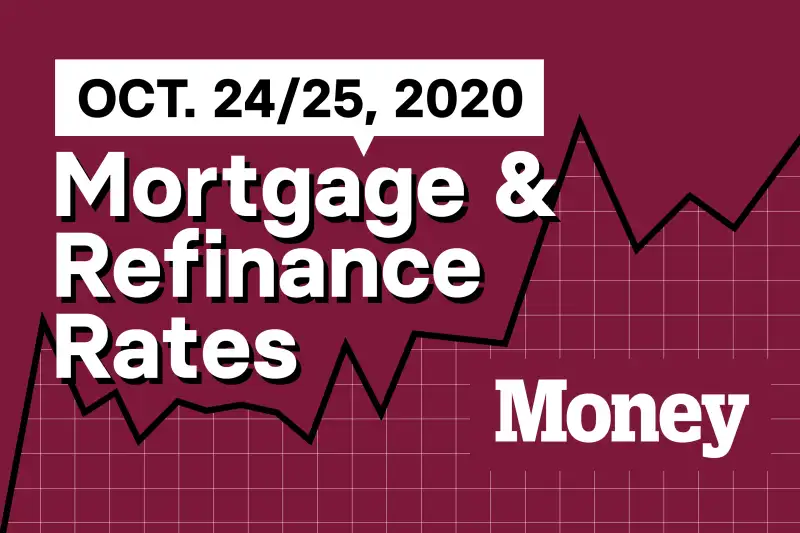Today's Mortgage and Refinance Rates for October 24 and 25

The average rate for a 30-year fixed-rate purchase mortgage was 3.576% on Thursday. The average rate for a 30-year refinance was 4.335%.
Money's most recent mortgage rates include data from over 8,000 lenders across the United States and are updated daily. These rates include discount points and represent what a borrower with a 20% down payment and 700 credit scores — roughly the national average FICO score — would have been quoted.
| 30-year fixed-rate purchase mortgage |
| 3.576% |
| Rate of October 22, 2020 |
Mortgage rates vary from state to state. On Thursday, borrowers in Illinois were quoted the lowest mortgage rates — at 3.367%. People looking for mortgages in Nevada saw the highest average rate at 3.817%. Nationwide, borrowers with the highest credit scores, 740 and above, were quoted rates averaging 3.082%, while those with credit of 640 or below were shown rates of 4.755% — a 1.673 percentage-point spread.
You may be able to negotiate a lower rate if you shop around or if you have other accounts with the lender. (Money's picks for the best mortgage lenders are here.) Currently, some banks are hiking up advertised rates to keep demand in check, so you may be offered a lower rate if you reach out directly.
Freddie Mac's widely quoted Primary Mortgage Market Survey put rates at 2.80% with 0.6 points paid for the week ending October 22, a new record low. The mortgage purchaser's weekly survey reflects borrowers who put 20% down on conforming loans and have excellent credit.
Refinance rates today
Money's most recent survey also shows that the offered rate for a 30-year refinance for someone with a 740 credit score was 3.758% on Thursday. Last October, the average mortgage rate (including fees) was 3.859%.
| 30-year fixed-rate mortgage refi |
| 3.758% |
| Rate of October 22, 2020 |
A homeowner with a $200,000 mortgage balance currently paying 3.859% on a 30-year could potentially cut their monthly payment from $939 to $927 by financing at the current lower rates. To determine if it's worth it to refinance your mortgage, also consider the closing fees you paid on your current mortgage, how much your new lender is charging and how long you have left on your loan term. (Our picks for the best lenders for refinancing are here).
The Week in Review
Mortgage rates continued to drop this week as demand remained high and inventory sunk further.
Interest rates set a new low Thursday, marking the eleventh record this year and the second in as many weeks. Mortgage rates averaged 2.80% for the week ending October 22, according to Freddie Mac. Record-low interest rates continue to spur demand, particularly in the refinancing market, as homeowners look to reduce their monthly payments and homebuyers look for larger homes.
The total number of mortgage loan applications ticked down 0.6% for the week ending October 16, according to the Mortgage Bankers Association. Applications for purchase loans decreased by 2% week-over-week but were still 26% higher than the same week last year. Refinance loans ticked up 0.2% from last week and were 74% higher year-over-year. Refinance requests made up 66% of all applications.
The number of mortgage loans in forbearance plans saw another large drop this week as more homeowners exited payment deferral plans. According to the MBA, the total number of loans in forbearance fell below 6% for the first time since the pandemic began, reaching 5.92% of all loans.
The decrease occurred across all loan types, with the share of Fannie Mae and Freddie Mac loans decreasing by 26 basis points. It's the 19th straight week of declines for loans held by the government-sponsored mortgage investors. Private-label securities and portfolio loans saw the largest drop, decreasing by 120 basis points. The share of Ginnie Mae loans, which include government loans such as VA and FHA loans, in forbearance also decreased, down by 13 basis points.
The drop is due in large part to the expiration of the original six months of forbearance that was granted by the CARES Act in March. Homeowners who are still in distress as a result of the COVID-19 pandemic can request an additional 6 months of forbearance, but they must contact their loan servicer to request the extension.
On Wednesday the MBA announced its forecast for 2021. Next year the trade group expects overall originations to decrease to $2.49 trillion. However, it expects purchase loan originations to increase 8.5% to $1.54 trillion — surpassing the previous record of $1.51 trillion set in 2005. Meanwhile, it sees refinance applications, which so far this year have been 71% higher than last year, dropping 46% to $946 billion.
The forecast is based on the assumption that an effective vaccine will be available to combat the spread of COVID-19 sometime next year. The MBA estimates that total mortgage originations will reach $3.18 trillion by the end of 2020, which would be the highest amount since 2003.
Existing home sales rose to a seasonally adjusted 6.54 million units in September, according to data from the National Association of Realtors. This represents a 9.4% increase over August numbers and a healthy 21% increase over September 2019, when the sales were at an annual rate of 5.41 million units. The numbers include single-family homes, condominiums, townhomes, and co-ops.
While the NAR's report highlights the strength of the housing market, much of the unusual gains we're seeing during the fall buying season are thought to be a result of the pandemic's effect on the housing market and seasonal adjustments. The details in the report show that most of the gains are coming from high-value homes. Sales of properties priced over $1 million increased by 106.5%. Sales of homes priced between $100,00 and $250,000 were up 4.3%, while homes under $100,000 were actually down 16.3%.
According to NAR, the median home sale price increased from $271,500 last September to $311,800 last month. It marks the 103rd consecutive month of home price increases across the nation. Meanwhile, according to real estate platform Zillow, the typical home value reached $259,906 in September.
Home values are increasing at the fastest pace since 2014, increasing by 5.8% year-over-year. And while every major city experienced a year-over-year price growth, the highest gains were seen in Phoenix, which grew 11.7%, followed by San Jose at 11.5%, and Seattle at 10.7%.
While the level of activity in the housing market remains well above the norm for this time of year, there are signs that the typical fall cool down could finally be making an appearance. Realtor.com's Weekly Housing Report indicates that home price growth slowed down for the week ending October 17, while the decline in the number of available homes and the pace of sales appear to be stabilizing.
The median list price increased by a little over 11% last week, down from the 12.9% price acceleration that occurred during the first week of October. Despite the slight decrease, the median home price remained at $350,000, which is high for this time of year.
New listings were down 6% year-over-year, a slight improvement over last week as more new listings are coming onto the market. The pace of sales also slowed down slightly, as homes were selling 13 days faster than last year, one day slower than last week. It marks the fourth straight week where homes have sold about two weeks faster than in 2019.
Inventory still remains the biggest concern for the housing market. According to the NAR, inventory took a big hit in September, decreasing to 1.47 million units, which is just a 2.7-month supply at the current pace of sales. At the end of August there was a 3-month supply and a 4-month supply last September.
However, there could be some relief on the horizon as home builders have a positive outlook for the next six months. According to the National Association of Home Builders, home-builder sentiment reached an all-time high of 85 during the month of October. The NAHB index measures current sales conditions, sales expectations for the next six months, and prospective buyers. An index rating above 50 means home builders view conditions as being good rather than poor.
According to the U.S. Census Bureau, overall housing production was up 1.9% month-over-month in September to an annually adjusted rate of 1.42 million housing starts. Single-family starts, which are the homes most in demand at this time, were at an annual rate of 1,108,000, up 8.5% over August and 11.1% from the same time last year. This is the highest pace of single-family starts since 2007.
Building permits increased a little over 8% to an annually adjusted rate of 1,553,000. Housing completions were at an annually adjusted rate of 1,413,000 units, an increase of a little over 15% over August, and a robust 25.8% over September of last year. Increased housing production is needed in order to ease the housing inventory shortage.
The labor market showed greater than expected improvement, as the initial jobless claims totaled 787,000 for the week ending October 17. Claims came in 55,000 lower than last week's revised total of 842,000 and well below economists expectation of 875,000. Continuing claims decreased by over 1 million to a total of 8,373,000. Meanwhile, the seasonally adjusted insured unemployment rate dropped below 6% for the first time since the pandemic began, coming in at 5.7%.
More from Money:
The Home Buyer's Dilemma: As Mortgage Rates Fall, House Prices Soar out of Reach
Savvy Homebuyers Are Using an Under-the-Radar Strategy to Win Bidding Wars in 2020
New Construction Home Sales Are Soaring, but Financing a Purchase Can Be Tricky
Rates are subject to change. All information provided here is accurate as of the publish date.
